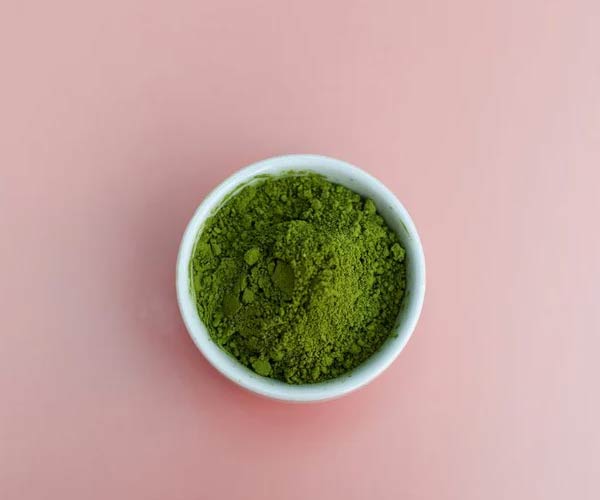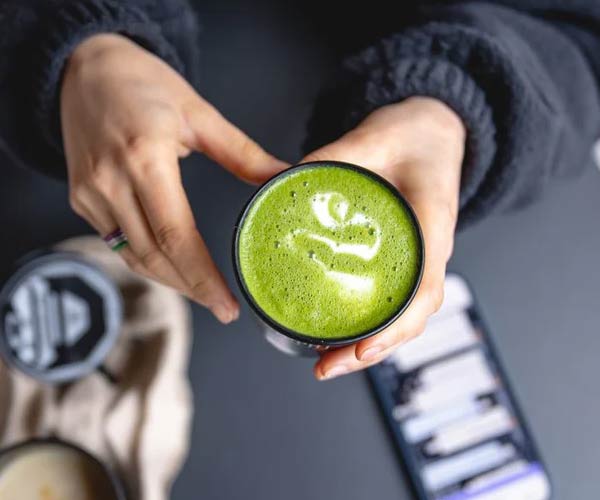Matcha, like regular green tea, is made from the leaves of the tea plant Camellia sinensis, but differs from traditional green tea varieties in several respects. The most obvious difference is that matcha is prepared in powder form, rather than the traditional method of brewing leaves.
You can easily tell the quality of a matcha by its color. The strong green of a ceremonial grade matcha is caused by the very high chlorophyll content, which is achieved because the tea plants used to make matcha are grown in the shade for three weeks.
To make genuine, high-quality matcha, the stems and veins are removed after the tea leaves are picked, leaving only the leaf pulp. The leaves are then ground into a very fine powder, which is mixed with hot water during preparation. The big difference from regular tea is that you consume the entire leaf at the end, not just an infusion.
Matcha is now even more popular than traditional green tea because of its incredible health benefits, coupled with a great, delicious, creamy texture and a lovely, earthy flavor.
But what many people don't know is that this beautiful green powder has much more to offer. Here we list 15 facts you may have never heard of.
1. Matcha is the only tea in the world that you consume completely
As briefly mentioned above, with matcha, you're not just drinking an infusion of the tea leaves, but the entire leaf, which you've dissolved in water in powder form. This makes matcha unique in the world of tea, both in its preparation and in its drinking. However, "dissolving" might be the wrong term, as the matcha doesn't actually dissolve, so you shouldn't let your matcha stand for long; instead, you should consume it immediately, before the small powder particles settle to the bottom.
A big advantage of consuming the whole leaf is that you absorb much higher amounts of antioxidants and phytochemicals.
2. Matcha is healthier than regular green tea
I've already mentioned that you don't just brew leaves and drink the infusion, but consume the ground leaf in its entirety. This way, you'll ingest much larger amounts of beneficial health substances.
Most people already know that green tea generally contains large amounts of antioxidants and amino acids, but matcha has even more to offer.
Matcha has 15% more amino acids than other green tea varieties, lowers your blood pressure, boosts your cardiovascular health, supports weight loss, and improves liver function.
Matcha contains a very high amount of EGCG, a phytochemical (catechin) that has anti-inflammatory effects, improves cognitive function, and even helps prevent cancer. Because the tea plants used for matcha are shade-grown, they produce more of the amino acid called L-theanine than traditional green tea. This L-theanine has a calming effect and increases your focus.
3. Matcha was invented by mistake
The original matcha, brought to Japan from China at the end of the 12th century, was actually a completely different product than the matcha we know today. Back then, matcha was simply roasted and ground.
Today's matcha was more of a temporary solution and came about when farmers discovered "Oishita cultivation," which means growing the plants in the shade. How did this happen? Well, during a really harsh winter, they had to cover the tea plants with straw and reeds to protect them from frost. This resulted in a lack of sunlight, and the plants produced more chlorophyll for more intense photosynthesis.
So, it wasn't planned that matcha would be produced this way, but rather purely as a protective measure. The farmers harvested the much greener leaves and were thrilled with the much creamier and more intense results, so they continued to produce matcha this way.
4. Matcha supports weight loss
The catechin EGCG has thermogenic properties that support fat oxidation. Fat oxidation refers to the breakdown of stored fat reserves in the body through the oxidation of fatty substances by oxygen, the well-known fat burning process.
So you burn calories even when you're not moving at all, but that doesn't mean you should stop exercising from now on.
Another important point is that matcha contains L-theanine and caffeine, which together create a compound that increases your energy and helps you focus better. Last but not least, it's worth mentioning the antioxidants, which boost your metabolism and help your body burn fat more easily.
5. Matcha contains more caffeine than coffee
We all drink way too much coffee, don't we? Matcha is a much healthier alternative without giving up caffeine. So if you need your morning fix to get you going, give matcha a try.
Matcha is much more digestible than coffee, but has an even higher caffeine content than most coffees. You can drink matcha several times throughout the day without any of the side effects associated with coffee.
A cup of matcha contains approximately 70mg of caffeine, while an espresso only has 64mg.
6. Matcha is a superfood for your brain
Matcha is a true brain booster and has been proven to improve cognitive function. Matcha contains polyphenols, amino acids, L-theanine, and a high concentration of antioxidants; this combination is perfect for improving alpha waves in your brain. Your focus improves, and you can think more clearly.
Added to this is the effect of caffeine, which helps you stay alert but also calm at the same time.
7. You can recognize good matcha powder by its color
The easiest way to judge the quality of your matcha is by its color. A truly high-quality matcha powder will have a blue-green hue; if the color leans toward brownish or yellowish, it's probably of lower quality.
If only the best, young leaves are used in production, you get a color that's somewhat reminiscent of the green of a pine forest. In Japan, a distinction is made between "pine green," a high-quality matcha, and "bamboo green," a lighter shade of green with nuances, meaning a less high-quality matcha.
The best matchas, with the most beautiful, vibrant colors, are the product of a special picking method called "Niyou Tsumi," which translates as "two-leaf" picking. This involves carefully harvesting the top, youngest pair of leaves from the stem of the tea plant.
8. You can also recognize a good matcha powder by its aroma
Matcha experts have a term for the aroma of high-quality matcha, which is called "oika." Oika is a characteristic, fresh aroma found exclusively in shade-grown tea. Besides matcha, high-quality Gyukuro tea also has a similar aroma.
9. Matcha has a mysterious fifth taste
Anyone who has ever tasted a truly good matcha can report a mysterious taste that is difficult to describe or classify. It is neither sweet, salty, bitter, nor sour. Matcha is one of the few foods in the world with this fifth taste, called "umami."
This flavor is created by the high concentration of glutamate, theanine, and other compounds. Umami is really hard to explain; the best way to experience it is to try a really good matcha.
10. Samurai drank matcha before battle
Let's travel back to the 13th century... Buddhist monks shared their knowledge of the health benefits of matcha with the samurai. The warriors learned that consuming matcha before battle had beneficial properties.
In accordance with their very strict code of conduct, the samurai created the first version of the Japanese tea ceremony. Before battle, they performed a tea ceremony to mentally prepare for the tough battle. The beneficial properties of matcha helped the warriors increase stamina and energy. Matcha also had a positive effect on wound healing and the mental stress the warriors endured.
11. Matcha, the companion of the monks
Drinking matcha tea is an ancient tradition. Centuries ago, Zen Buddhist monks began incorporating a matcha ceremony into their meditative practice. At the beginning of their meditation, they would prepare and consume matcha tea to enjoy its benefits during meditation.
It may sound strange to consume a circulatory and nervous system stimulant like matcha during meditation, but matcha is anything but an ordinary stimulant.
Yes, matcha contains a fair amount of caffeine, but it's a different type of caffeine than what we usually find in coffee. One teaspoon of matcha contains about 70 mg of theophylline caffeine. Due to its shade-grown nature, matcha contains higher amounts of theophylline than regular green tea.
Theophylline, unlike coffee, provides a more sustained and powerful energy boost without causing anxiety, a caffeine crash, or a temporary increase in blood pressure like coffee. Instead of the jittery effects of coffee, matcha provides a calming feeling of euphoria that combines mental alertness with deep relaxation. It's a sustained feeling, similar to a meditative state.
In addition to theophylline, matcha tea also contains a rare amino acid called L-theanine, which promotes alertness and relaxation—and it contains natural antioxidants that can help reduce anxiety and induce a sense of calm.
12. The taste of matcha changes depending on the water temperature
Matcha's flavor profile is influenced by three main elements, which are extracted at different temperatures. Depending on your taste, you can whisk your matcha with hotter or cooler water.
The three flavor profiles are as follows:
Theanine – Responsible for the soft, sweet taste.
Catechin – Causes a rather bitter taste.
Caffeine – This creates the slightly bitter taste.
Theanine is actually quite insensitive and can be extracted at both low and high temperatures. Catechin and caffeine react most strongly at temperatures above 75 °C.
If you want a mild, smooth matcha, try keeping the water temperature below 65°C. This will extract more theanine but less catechin and caffeine. In our opinion, the most aromatic and balanced matcha is achieved at a water temperature of 70°C. You can achieve this temperature by first boiling your water completely and then letting it cool for about 2 minutes.
As you can see, matcha has a lot to offer, and we hope you'll enjoy your cup of matcha even more than before. If you'd like to learn more about matcha, you'll find even more interesting facts in our blog...



Leave a comment
This site is protected by hCaptcha and the hCaptcha Privacy Policy and Terms of Service apply.